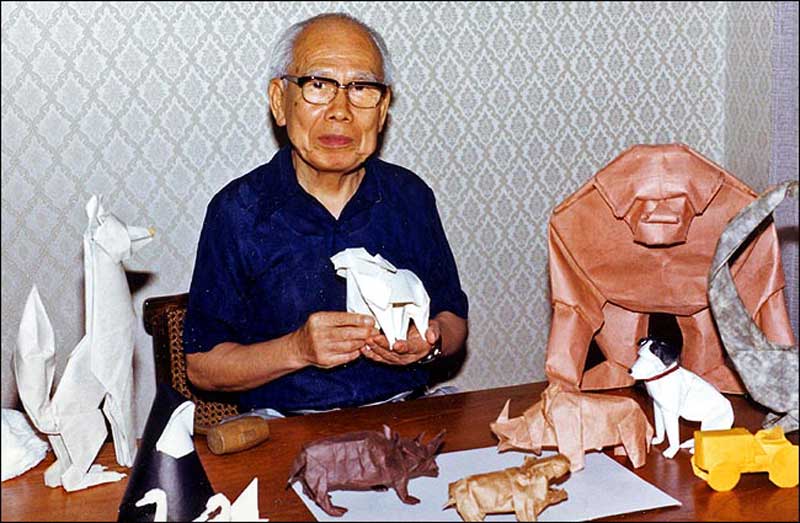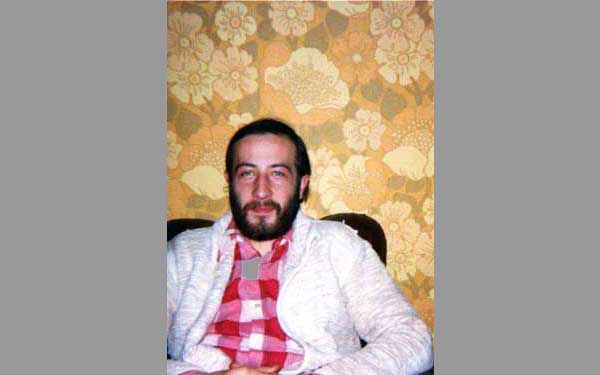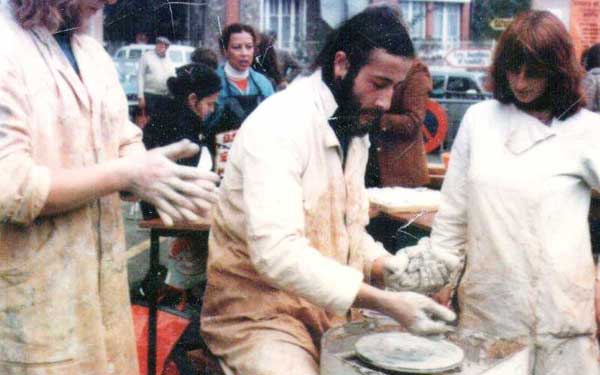
Eric Joisel : About
Eric Joisel was born on November 15, 1956. He passed away from lung cancer on October 10, 2010 surrounded by his family and close friends.
Eric began drawing and sculpting when he was seventeen years-old. He started creating origami in 1983 and four years later, had his first exhibit in the Espace Japon Paris. Eric became a professional origami artist in 1992.

Eric Joisel in his home studio
Career Highlights
1987 1st origami exhibition “LA MENAGERIE DE PAPIER”, Espace Japon, Paris
with Usataro Kimura, Japanese artist living in France
Exhibition and entertainment for a “Japanese Week”, City of Reims
AGENCE FUSION: folds designed for the B.A.I.I.
1988 Exhibition and events for a “Japanese Week”, City of Vittel
Exhibitions in different Parisian BNP
Exhibition and activities for “LE JAPON A LEVALLOIS-PERRET”, 1 month
1989 Exhibition and events for MONTEVRAIN Stationery, Graphitec, Villepinte
Exhibition and activities “L’ETANG DE PAPIER”, Espace Japon, Paris, 5 weeks
Exhibition and activities at the JARDINS D’ARCADIE, Strasbourg
1990 Numerous Exhibition and activities for libraries and Cultural Centers
1991 Exhibition and events “LA MER DE PAPIER”, Espace Japon, Paris, 5 weeks
Exhibition and activities 14th Festival de la Foire Saint-Germain, Paris
Inauguration of the STRACEL paper mill, Strasbourg
1992 PARTIUMS CARTIER, foldings photographed for several POS displays
Numerous exhibitions and events for libraries, cultural centers, …
Facilitator training
1993 “Festival du Vent”, Calvi
Beginning of collaboration with France-Origami,
Exhibition and activities at the Villiers-en-Bière shopping center, 15 days
1994 Exhibition and animations “Arts and Traditions of Japan”, Creil
Shopping centers “Bordeaux Lac”, “Vannes”, “Vélizy 2”, “St-Quentin-en-Yvelines”
Numerous exhibitions and events for libraries, cultural centers, …
1995 Exhibition and animations Stand HEWLETT PACKARD, Apple Expo, Paris
Shopping centers “Brest”, “Lyon-St-Priest”, “Pau”, “Annecy”, “Montpellier”,
“Rennes”, “La Ricamarie”, “Angoulême”
Editor-in-chief of the newspaper INFOPLI, for the company France Origami
1996 Shopping centers “Aix-en-Provence”, “Avignon”, “Grenoble”, “Limoges”, “Orléans”
Hedgehog model awarded by the Nippon Origami Association, Tokyo, Japan
Southeast Origami Festival, Charlotte, NC, USA
1997 Exhibition and animations OCE consumables stand, MICAD, Paris
Television evening Thema “LE PLI”, Arte
Inauguration of a new ARJOMARI WIGGINS paper, Ketchum agency
1998 Artistic director of the “PARIS-ORIGAMI” Festival, Carroussel du Louvre, Paris,
20 of the main world creators, 2,000 m2 of exhibition-animations,
Main sponsor: “Papeteries de Gascogne”.
Southeast Origami Festival, Charlotte, NC, USA
1999 Invited by Akira Yoshizawa for his exhibition at Matsuya Ginza, Tokyo
Numerous exhibitions and events for libraries, cultural centers, …
2000 Southeast Origami Festival, Charlotte, NC, USA
Numerous exhibitions, events and events for Art Management
Guest of honor at the CDO convention, Castel San Pietro, Italy
2001 Beginning of collaboration with Art Management
2002 Guest of honor at the Southeast Origami Festival, Charlotte, NC, USA
Numerous exhibitions, events and events for Art Management
2003 Training for packaging technicians
Numerous exhibitions, events and events for Art Management
2004 Guest of honor at the JOAS convention, Tokyo, Japan
Numerous exhibitions, events and events for Art Management
2005 “MASTERS OF ORIGAMI”, July to September, Salzburg, Austria
Realization of a set of animals for the company HAGEN, France
Numerous exhibitions, events and events for Art Management
2006 Numerous exhibitions, events and events for Art Management.
2007 Numerous exhibitions, events and events for Art Management
Guest of honor at the BOS convention, Cambridge (England)
PCOC convention guest of honor, Vancouver (Canada)
2008 Interview for a private Japanese TV, Tokyo (Japan)
Participation in Orange television advertising, Sté Partizan
Guest of honor at the JOAS convention, Kobe (Japan)
Guest of honor at the convention in Jerusalem (Israel)
Personal exhibition at the Origami House, Tokyo (Japan)
Guest of honor at the CDO 30th anniversary congress, Verbania, Italy
2009 Participation in the exhibition “P.A.P.E.R.”, Seattle, WA (USA), July
Participation in the exhibition “El arte de papel plegado”, Zaragoza, Spain (Sept-Nov)
Article in “NATIONAL GEOGRAPHIC”, culture page, October
Guest of honor at the Lyon convention (France)
2010 Personal exhibition with Naomiki SATO at Espace Japon, Paris (France) in January.
Guest of honor at the Zaragoza convention, Spain (August)
Eric with family and friends
Brief History of Origami
 Paper was invented in China around 105 AD. During the seventh century, a Korean master of paper manufacture brought paper into the Japanese Court. Japan’s Prince Shotoku was so impressed that he planted forests specifically to produce a better quality origami paper. At this time, paper was very rare and expensive and only used by the wealthy. Its primary use was for Shinto ceremonies, with models only known by priests. This first origami was abstract and symbolic. Centuries later, paper became more common and cheaper to produce. Origami began to be used for amusement. The models figured on the left, including the famous crane, the symbol of Peace, are probably 1,000 years old, however up until the 20th Century, there were only a few hundred models, all of them very simple and designed especially for children.
Paper was invented in China around 105 AD. During the seventh century, a Korean master of paper manufacture brought paper into the Japanese Court. Japan’s Prince Shotoku was so impressed that he planted forests specifically to produce a better quality origami paper. At this time, paper was very rare and expensive and only used by the wealthy. Its primary use was for Shinto ceremonies, with models only known by priests. This first origami was abstract and symbolic. Centuries later, paper became more common and cheaper to produce. Origami began to be used for amusement. The models figured on the left, including the famous crane, the symbol of Peace, are probably 1,000 years old, however up until the 20th Century, there were only a few hundred models, all of them very simple and designed especially for children.
Paper was introduced in the West by Arabians who learned of this commodity through Chinese prisoners. As a result of the Arab conquest of Spain, paper began to be manufactured in Europe. Spanish culture has had a long tradition of paperfolding culminating in Miguel de Unamuno’s “Traité de cocottologie.” In the early 20th Century, origami was practiced at the Bauhaus school.
It was only in the mid 20th Century that origami made its quantum leap. In the 1950’s, a Japanese master incorporated the mechanical craft of folding paper with the artistic aesthetic of sculpture. Akira Yoshizawa created thousands of new models where only a few hundred existed before. All Yoshizawa-san’s origami models sprung from a highly refined artistic version. Yoshizawa-san opened the door for the entire world to discover that origami was not just a children’s hobby, but a complex, sophisticated art-form that transformed a single piece of paper into a beautifully crafted work of art. Yoshizawa-san and Samuel Randlett created the living legacy of international symbols that today lets millions of people share in the creative process of origami.
Today, origami is practiced all over the world. With the proliferation of hundreds of books and websites, there are countless skilled origami artists working in many different directions. Japan’s Tomoko Fuse develops modular origami – puzzles using not only one square but many intricate units folded together. America’s Robert Lang, a laser physicist, creates insects more “alive” than real live ones. Britain’s Paul Jackson reflects on minimalism using the fewest number of creases possible. Some creators prefer to use triangles or rectangles instead of squares; others recycle material like tea-bags or train tickets. My personal preference is to try and imitate the philosophy of Master Yoshizawa – to breathe live into the paper and improvise as my as I can. Like a good piece of jazz, every model I produce is unique. And most of my models are 3D. Through the use of many curves, I attempt to put volume into my work so that at the end of the process, they become life-like.”

Akira Yoshizawa


Eric’s burial crypt,
Enghien-les-Bains, France

“The Monk”, last model folded by Eric Joisel

“Eric Joisel is one of the preeminent origami artists in the world. Unlike many other origami artists, Eric has formal art training and had practiced art as a painter, a sculptor and and a potter before turning to origami. The influence of this experience on his origami work is clear: here is a depth and maturity to his work that few other origami artists can even approach. Eric does not rely on technical ingenuity in creating his sculptures. Instead, he works and reworks his designs until they are perfect.”
Joseph Wu


















